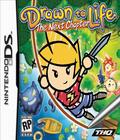Some games combine the right mix of elements to create an exceptional game, and Drawn to Life was a surprising example of this. Initially, it sold rather poorly due to rather tepid reviews that weren't sure if the game was the smartest idea or was well implemented. The intended kid's market, with a periphery demographic that didn't find the creative elements to be sufficient, didn't get the game selling until THQ quickly slammed out a SpongeBob SquarePants Edition, which not only sold like hotcakes, but also kick-started sales of the original title. Now, THQ has gotten around to doing a proper sequel with Drawn To Life: The Next Chapter and a separate sequel on the Wii, under a different developer and with a different plot. All the strengths are here and tighter than before, but with the catch of making the game's largely unfixed weaknesses a little more visible.
The basic story remains similar. The Raposa are fuzzy, cute things that are in danger, and you've got to help save the world from a painting-themed evil. Rather than darkness being the source of evil, the draining of color is the threat this time around. Forced from their village, the Raposa call on the help of the Creator — that's you, the player — who responds with a few disses at Wilfre, provide a giant turtle to serve as a boat, and set up a marionette as a new hero.
The core gameplay is the same as before. It's about the most stereotypical action-platform gameplay you can devise, and it's clearly designed for kids and virtually devoid of challenge in the best of ways. (We'll get to the tweaks in a few minutes.) Fortunately, the core remains nicely wrapped up in basic, enjoyable adventure gameplay; surprisingly strong storytelling that makes full use of a wide variety of characters; and, of course, the raw joy of sketching things.
Most of the gameplay is spent experiencing the story in a fashion that hybridizes adventure gameplay with a plot that's similar in most important ways to a typical JRPG, albeit with much more dynamic characters. The 2-D sprites of the Raposa are exceptionally effective at conveying emotion and interaction. Most of the time (with a few surprises), 5th Cell puts this to good use, with silly behaviors and heartwarmingly touching slips of the tongue. The quality of storytelling has improved since the first, and the game ties the plot into the gameplay just tightly enough to justify experiencing the other half of the game.
The actual platform gameplay has been improved, too, even if it's still devoid of challenge. You still regularly find platforms to sketch different things into the game - changing how power-ups, support platforms, and other pieces look. You still have a basic, one-swipe sword attack, and can jump on enemies to take them down. What's new is of moderate importance, generally. You get two different weapon types in addition to the basic slasher, and you can freely switch between them — or choose to go unarmed. The biggest new ability that players get is two alternate forms: Blobs squeeze into tight spaces and can Katamari things up, while spiders can climb walls and even spit webs, which you also draw. The game's regular habit of having you draw in platforms has been replaced with small, puzzle-based sections, which allow you to sketch short platforms under increasingly tight constraints in an attempt to reach the door.
It wouldn't be Drawn to Life without being able to sketch characters, and that too is improved, with a set of new commands that basically combine into being a complete DS implementation of Microsoft Paint. Airbrushing, dropper tool and 64 colors let you draw whatever your art skills can devise. (Mine weren't very impressive, but that was part of the charm, honestly.) Your hero is also more customizable than before; you can add up to two extra limbs and adjust their placement and scale more finely. Cat with a prehensile tail? Sure. Octopus? Why not! The sky is still the limit; it's just that the cloud line has moved up massively, especially when you consider the alternate forms.
The graphics and sound remain solid, with watercolor-style overworlds, more ornate stages, and a general proof that 5th Cell's imagination isn't just limited to "How can we let you be imaginative for us?" In particular, the emotion that the NPCs show is far more effective than before, and the effects for the draining and restoring of color to environments get the point across in a wonderful fashion that manages to avoid being scary. The music is still unexceptional but perfectly listenable, and the sound effects now have some bits and pieces of well-done voice work to add some variety. Most other sounds are the same as they were in the original title, which is perfectly acceptable.
Just like last time, Drawn to Life: The Next Chapter is all about what you make of it in terms of how you draw and how creative you think. It's no surprise, given the developer's other recent game. While the gameplay can't exactly be hailed as superior to their self-made rival product, the Drawn to Life sequel opens up the imagination in new ways, just as the original did, and the improved storytelling makes it highly worth the while of the young and young-at-heart gamers who are still a core audience of the DS.
Score: 7.8/10
More articles about Drawn to Life: The Next Chapter











 Featuring an innovative new action drawing feature and enhanced drawing tools, Drawn to Life: The Next Chapter will give players new creative tools and immerse them into new worlds they create and explore.
Featuring an innovative new action drawing feature and enhanced drawing tools, Drawn to Life: The Next Chapter will give players new creative tools and immerse them into new worlds they create and explore.
































